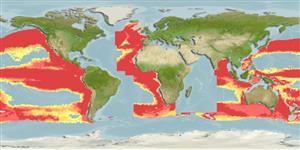Classification / Names
Common names from other countries
Main reference
Size / Weight / Age
Max length : 11.9 cm (female)
Environment
Marine; bathypelagic; depth range ? - 2500 m (Ref. 86949)
Climate / Range
Deep-water, preferred ?
Distribution
Short description
Dorsal
soft rays
(total): 6-7;
Anal
soft rays: 5 - 7. Characterized by having large melanophores inside the rays of the caudal fin; metamorphosed females have ethmoid region of the cranium extremely flattened dorsoventrally; deep and wide illicial trough, nasal foramina narrow and elongate; absence of symphysial spine of lower jaw; dentaries forming thick, broad, posteriorly directed flange immediately lateral to their union on the midline, ventral margin of lower jaw at symphysis concave when viewed anteriorly; short illicium of pterygiophore, posterior part broad and dorsoventrally flattened; metamorphosed females having wide ethmoid cartilage and vomer, width about equal to distance between anterolateral tips of lateral ethmoids and frontals; absence of vomerine teeth; short frontals, anterior end overhanging and extending past anterior limits of the ethmoid cartilage and vomer, convex dorsal margin; well developed first ray of dorsal fin; dorsal fin rays 6-7; anal fin rays 5-7; short and broad pectoral fin lobe, shorter than the longest rays of pectoral fin; pectoral fin rays 21-27; coracoid lacking posteroventral process; pelvic bones, simple and expanded distally; skin naked, without dermal spinules; darkly pigmented skin of caudal peduncle extends well past base of caudal fin; metamorphosed males have posterior nostril contiguous with the eye, nasal area is white and with 18 olfactory lamellae, 7-9 upper denticular teeth fused at bases and 4 lower denticular teeth (Ref. 86949).
IUCN Red List Status (Ref. 115185)
Threat to humans
Harmless
Human uses
More information
Common namesSynonymsMetabolismPredatorsEcotoxicologyReproductionMaturitySpawningFecundityEggsEgg development
Age/SizeGrowthLength-weightLength-lengthLength-frequenciesMorphometricsMorphologyLarvaeLarval dynamicsRecruitmentAbundance
ReferencesAquacultureAquaculture profileStrainsGeneticsAllele frequenciesHeritabilityDiseasesProcessingMass conversion
Tools
Special reports
Download XML
Internet sources
Estimates of some properties based on models
Phylogenetic diversity index
PD50 = 1.0000 many relatives (e.g. carps) 0.5 - 2.0 few relatives (e.g. lungfishes)
Trophic Level
3.8 ±0.6 se; Based on size and trophs of closest relatives
Resilience
High, minimum population doubling time less than 15 months (Preliminary K or Fecundity.)
Vulnerability
Low to moderate vulnerability (29 of 100)
Price category
